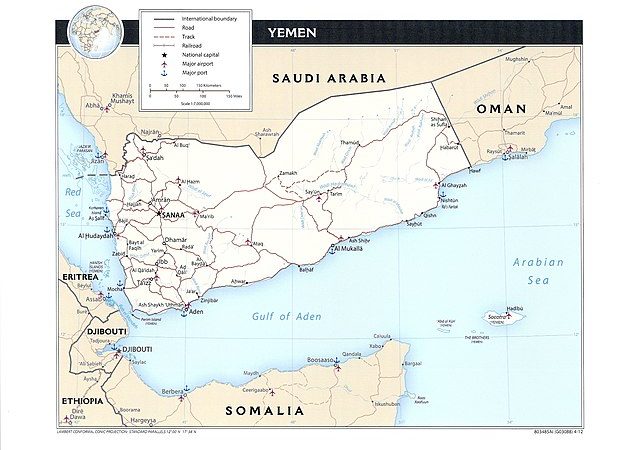In 2015, Yemen, a country unknown to many in the West, began a war in defense of its sovereignty that was being threatened by an interventionist alliance led by Saudi Arabia. The Yemeni people had to pay with the lives of almost 400,000 of their children to maintain their independence. Many people have wondered how it has been possible for a country considered the poorest in Western Asia to have been able to resist and defeat a coalition made up of some of the richest countries on the planet.
Although the conflict has continued for almost a decade, it appears to have reached a situation that could lead to a possible cessation. Although a tense situation and warlike actions of different kinds remain, there has been a reduction in military actions in recent months. It is no longer a total war, but peace has not come either. Under the mediation of China, Saudi Arabia and Iran reconciled, paving the way for overcoming several conflicts in Western Asia and North Africa. Apparently, Yemen is one of them.
Now, after the Israeli invasion of Gaza, Yemen, together with the Lebanese Hezbollah movement and other Arab and Muslim revolutionary forces, has taken an active role in solidarity with Palestine. Once again, Yemen has surprised everyone by making decisions that not only have a local impact, but also a regional and global one. Once again, the world has wondered how this could have happened. In two installments, I am going to present some elements that allow readers to get to know Yemen, learn about the historical struggle and the heroism of its people to help understand the scope and dimension of the Yemeni decision to support with all resources at its disposal the just struggle of the Palestinian people.
The Republic of Yemen is located in a strategic place on the planet, in a region where trade routes connect Asia, eastern Africa and the Mediterranean. Its territory, located on the coasts of the Arabian Sea and at the gates of the Red Sea, dominates the Strait of Bab el Mandeb, placing it in a privileged place on the globe, especially since the 20th century when, on the one hand, there were discovered in the region large energy deposits (oil and gas) and on the other, when considering the enormous economic growth and development of East Asia that transformed Yemen into an obligatory passage for most of world trade.
The ancient cities of the territory were unified in ancient times into the biblical kingdom of Sheba. From that moment on, the struggle of the inhabitants of the current Yemeni surface for their liberation and independence began, as they had to face the Roman Empire in the 1st century AD. The powerful Rome was defeated in its attempt at domination.
Unlike the rest of the Arabian Peninsula, current Yemen had prodigious vegetation that provided great wealth to its population due to the great possibilities for consumption and trade it offered. Thus, the Greek mathematician Ptolemy is credited with naming Yemen as “happy Arabia.”
In the course of history, the Yemenis had to fight with Himyarites who, from their Jewish religion, persecuted the majoritarian Christian population until the intervention of the Ethiopians in the 6th century. Islam arrived in the region during the 7th century, beginning to shape a culture that was based on the interweaving of varied knowledge that made great contributions to humanity.
However, for many centuries, Yemen remained outside the cultural and economic development established by Islam. It was in the 15th century when the territory of today’s Yemen began to gain strategic value. In their desire for commercial expansion, the Europeans began the domination of territories throughout the planet. The first Europeans to arrive in the region were the Portuguese, who dominated the country in order to control the sea route that allowed them to trade species from Asia to Europe through the Red Sea.
In the 16th century, the Ottoman conquest began with the occupation of some places on the Red Sea coast, while the interior of the country and the southern coast remained independent, governed by an imam. Shortly after, the English made their appearance in the area, installing a post of the Indian Company in the port of Moka on the Red Sea.
In the 19th century, the British expanded their presence by occupying the entire southwestern tip, settling in Aden in 1839, the best port in the region. At the same time, in 1872, the Turks managed to consolidate their dominance in the interior of the country, for which they settled de facto a hereditary monarchy in the name of a local imam. This division effectively split Yemen into two countries.
Around 1870, with the inauguration of the Suez Canal and the consolidation of Turkish rule over northern Yemen, Aden acquired new importance for British global strategy: it was the key to the Red Sea and, therefore, to the new canal.
At the beginning of the 20th century, Türkiye and the United Kingdom marked a border between their territories, which became known as North Yemen and South Yemen, respectively. In 1934 England secured control of the entire south of the country, up to the border with Oman.
During the First World War, the Imam allied himself with the Ottoman Empire and remained loyal to it until the end of the war, when the defeat of the Turks allowed Yemen to gain its independence in November 1918. However, Great Britain, after recognizing the independence of Yemen in 1920s, converted Aden into a protectorate and in 1937 into a colony. Once again, the Yemenis had to resort to armed struggle for independence. In 1940 the nationalist movement “Free Yemen” emerged to fight against the control of the country by the imams who had allied themselves with Great Britain.
The fighting took separate paths in the north and south. In 1962, the Yemen Arab Republic was created in the north, while in the south, the National Liberation Front, created in 1963, took Aden in 1967 and proclaimed independence, starting a socialist revolution.
South Yemen was renamed the People’s Democratic Republic of Yemen, closed all British bases in 1969, took control of banking, foreign trade and the naval industry, while undertaking land reform. In foreign policy, it maintained a close alliance with the Soviet Union. Likewise, it promoted an open anti-Zionist struggle and support for the Palestinian people.
In October 1978, at a congress that enjoyed considerable support from the population, the National Liberation Front founded the Yemen Socialist Party. In December, the first popular election since independence was held to appoint the 111 members of the People’s Revolutionary Council.
From the first years of its existence, the People’s Democratic Republic of Yemen, the country had to face the permanent hostility of Saudi Arabia, which aspired to control parts of the territory, precisely those in which oil deposits had been discovered. Tensions were aggravated by the growing US military presence in Saudi Arabia.
Meanwhile, in the north, the National Democratic Front (FND), which brought together all the progressive forces in the country, was developing the armed struggle against Ali Abdullah Saleh, who had come to government in 1978. When the FND was about to take over power, Saudi Arabia intrigued to divert the conflict into a war against the Democratic People’s Republic of Yemen. The mediation of some Arab countries led to a ceasefire and an agreement by which negotiations for reunification, suspended since 1972, were resumed.
Finally, on May 22, 1990, both republics were united to form the Republic of Yemen, which established that the political capital was Sana’a (former capital of the Yemen Arab Republic) and Aden (former capital of the Yemen Arab Republic) was designated as the economic capital. People’s Democratic Republic of Yemen). In a joint session of the Legislative Assemblies of both States held in Aden, a Presidential Council led by General Ali Abdullah Saleh was elected. The unification of Yemen was not seen well by Saudi Arabia, which is why it began a policy of supporting secession. In May 1994, secessionists proclaimed a Yemeni republic in the south of the country but were defeated by forces loyal to the government.
Between June and August 2004, a movement emerged that expressed the beliefs of a specific branch of Shiite-oriented Islam: the Zaidites, with its leader Hussein al-Houthi, who was a cleric. In honor of him, after his death in combat in September of that year, the movement assumed the name Houthi, Houthi or Ansarullah (supporters of God). Although this current is the expression of a minority in Yemen, its history is not recent. It dates back to the mid-8th century. Zaidism is identified by the greater preparation of its members and is associated with the fight for justice and the defense of Muslim ethics. This ideology, added to the position of marginality to which they were subjected after losing power in 1962, would form the substrate in which Houthi thought would develop in the future.
The Houthis’ fight against the pro-Western and pro-Saudi government of Ali Abdullah Saleh was long and bloody. They had to resort to arms on five occasions between 2006 and 2008 in defense of their territory in the north of the country until they began to expand their support base and the geographical space under their control. In 2009, Saleh, trying to stop the Houthis, turned to Saudi Arabia for support.
For the Houthis, the fact that a country like Saudi Arabia with a Wahhabi current, extremely conservative, was present and interfered in the country’s affairs was seen as a threat to the sovereignty of the nation in general and to theirs as a minority in particular. From that moment on, their struggle, which had a strictly internal character, became a confrontation against foreign intervention.
Although at first the Houthi fighters suffered harsh defeats, including (as mentioned before) the fall of their top leader, they grew stronger over time and from 2011, under the new leadership of al-Houthi’s younger brother, Abdul Malik, began to inflict significant setbacks on the enemy. The anti-imperialist and anti-Zionist rhetoric was strengthened by identifying Saudi Arabia as the executing partner of the United States and Israel’s plans in the area.
The so-called “Arab Spring” had a special influence on the growth of support for Houthi thought in their fight against Saleh’s repressive government. In Yemen, the earthquake that shook an important part of the Arab world had a much more organized response than in neighboring countries. Faced with the strength of the protests, Saleh fled the country and took refuge in Saudi Arabia, being replaced by his vice president, Abdo Rabbi Mansur Hadi, who tried to bring order to the country by reaching an agreement with factions opposed to Saleh “to change everything without changing anything,” leaving out the Houthi movement.
At the end of 2014, the Houthis decided to begin the offensive on the capital. In this context, Saleh – in a surprising attempt to regain power – established an alliance with the Houthis to confront Hadi. The Houthis, who had not supported the peace agreements signed by Hadi, allied themselves with their greatest enemy to take the capital. The Republican Guard, a force loyal to Saleh, favored the entry of the Houthis into Sana’a. Hadi fled to Riyadh, the Saudi capital, from where he “directs” the territories not yet controlled by Ansarullah, in reality acting as a puppet of the Wahhabi monarchy.
Once in power, the Houthis formed a Revolutionary Committee to run the country. Likewise, they were forced to fight simultaneously with the terrorist forces of Al Qaeda and with Saudi Arabia that protects them.
Saleh considered that the Houthis had not fulfilled the agreements that, according to him, meant that he had to assume power again and with Saudi support, he turned against them. When the betrayal was consummated, the Houthis attacked Saleh’s house, executing him on the spot.
From Riyadh, Hadi called for Saudi intervention in Yemen. Faced with this request, the Saudi monarchy organized a coalition of Sunni countries to launch in 2015 the “Decisive Storm” operation, structured around air attacks on the main enclaves controlled by the Houthis that would result in thousands of deaths.
This action was planned as a definitive offensive to take control of the country, in order to launch a second operation called “Restore Hope” focused more on diplomatic rapprochement. In reality, war activity did not cease at any time; on the contrary, the alliance’s land, air and maritime actions were reinforced by a naval blockade that prevented the entry of international aid, plunging the country into the worst humanitarian crisis in history. history until the current Zionist actions in Gaza were unleashed, both with explicit support from the United States.
The Houthis, making use of a wide margin of maneuver supported by greater and better knowledge of the terrain and wielding guerrilla warfare tactics inspired – according to them – by the liberation struggle of Vietnam and “the resistance movements in Latin America”, demonstrated great capacity to hit an invading army without combat disposition or morale and lacking discipline and motivation for battle. Likewise, the broad origin of the coalition soldiers, which has included the participation of a very large contingent of mercenaries hired by private companies, has reduced the combative capacity of the alliance led by Saudi Arabia.
Riyadh received forceful blows even in its own territory, when Ansarullah’s combative operations moved deep into Saudi geography through an advanced attack system using drones and long-range missiles that reached armed forces barracks, oil refineries and critical infrastructure works at very distant distances from the common border.
TO BE CONTINUED…









Leave a Reply